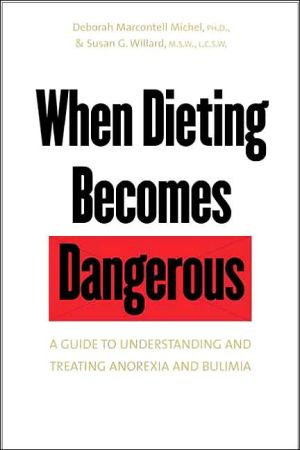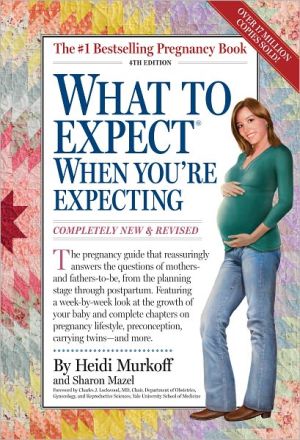When Dieting Becomes Dangerous: A Guide to Understanding and Treating Anorexia and Bulimia
What constitutes an eating disorder, and why does someone develop one? What can family, friends, and professionals do to help an individual suffering from a potentially devastating eating problem? This invaluable primer on anorexia and bulimia is written for patients and the people who care about them. In simple, straightforward language, two experts in the field describe the symptoms and warning signs of eating disorders, explain their presumed causes and complexities, and suggest effective...
Search in google:
What constitutes an eating disorder, and why does someone develop one? What can family, friends, and professionals do to help an individual suffering from a potentially devastating eating problem? This invaluable primer on anorexia and bulimia is written for patients and the people who care about them. In simple, straightforward language, two experts in the field describe the symptoms and warning signs of eating disorders, explain their presumed causes and complexities, and suggest effective treatments.
When Dieting Becomes Dangerous\ A Guide to Understanding and Treating Anorexia and Bulimia \ \ By Deborah Marcontell Michel Susan G. Willard \ Yale University Press\ Copyright © 2003 Deborah Marcontell Michel, Ph.D., and Susan G. Willard, L.C.S.W\ All right reserved.\ ISBN: 0-300-09232-6 \ \ \ \ Chapter One\ Introduction \ Historically, anorexia nervosa and bulimia nervosa may have existed in some form since the days of "starving saints" and Roman vomitoriums. Yet not until 1973, when Hilde Bruch published her classic text entitled Eating Disorders: Obesity, Anorexia Nervosa, and the Person Within, did anorexia become widely recognized as a psychological disorder. Bulimia did not receive much attention until the late 1970s, and in fact was not even given a distinct name until Gerald Russell coined the term bulimia nervosa in 1979.\ Today eating disorders constitute a major health concern. According to the National Eating Disorders Organization, between 5 million and 10 million girls and women, and 1 million boys and men, have some type of eating disorder. The American Psychiatric Association reports that more than 90 percent of those who have a diagnosis of anorexia or bulimia are female. In addition, there is evidence of an increasing prevalence of eating disorders, especially in countries that are more "Westernized" or "Americanized" in terms of cultural ideas of beauty and societal pressures to be thin. Complicating matters further, the options and resulting pressures on young women with regard to education and career are greater than in decades past, while the traditional values of success based on marriage and children prevail as well.\ Our young women are supposed to do it all: be thin and beautiful; have husbands and children; have professions, power, and money. In addition, our culture allows and promotes greater sexual freedom for women and girls, a phenomenon of our times that generates anxiety and fear around growing up. Thus, we see a frightening physical obsession begin to develop in girls as young as eight or nine years of age. The end product is that many girls and young women choose dieting as an imagined solution to their problems. This misguided attempt at coping may well lead to eating disorders.\ Eating disorders are complicated psychiatric illnesses in which food is used to help deal with unsettling emotions and difficult life issues. When the suspicion or realization of an eating disorder hits, many questions arise. We attempt to answer some of them as simply as is possible for such multidimensional disorders. Chapter 2 describes the diagnosis of eating disorders, the emotional features that are often seen, and the medical complications that may be present. Warning signs and symptoms are included. Chapter 3 provides general information on the typical characteristics-age, race, and level of education-of people with eating disorders. Chapter 4 explains the multiple factors that contribute to the development of an eating disorder. These include biological factors, sociocultural factors, individual personality characteristics, and family characteristics. Chapter 5 advocates a multidisciplinary approach to the treatment of eating disorders, and each professional's role is examined. We also give information on getting and staying well, treatment outcomes, and how one can assess quality and level of care. We raise the matter of insurance, as well. In Chapter 6 we give practical information and general advice to concerned individuals on their roles in effective intervention and treatment of someone with an eating disorder. In Chapter 7 we discuss the similarities of and differences between males and females in the development and treatment of eating disorders. The final chapter, intended for nonspecialist physicians, dentists, mental health professionals, and nutritionists, gives basic information on the assessment and care of persons with eating disorders. References for more detailed information are included.\ When Dieting Becomes Dangerous can be used as a reference book dealing with major questions about the development, diagnosis, and treatment of anorexia and bulimia. It will help you understand these disorders, and know what to do if you suspect that you, or someone you care about, has one of these illnesses. Our book can also be used to obtain advanced references for a more thorough understanding of these and related disorders. Finally, it can put you in touch with organizations that offer help.\ Chapter Two\ What Is an Eating Disorder? \ ANOREXIA NERVOSA\ Features of the Disorder The formal psychiatric name for this illness is anorexia nervosa, but it is often shortened to simply "anorexia." Anorexia nervosa should not be confused with general anorexia, which means loss of appetite. People who have anorexia nervosa do not lose their appetites; rather, they refuse to maintain a normal body weight. They lose at least 15 percent of normal weight for height and have an intense fear of gaining it back or becoming obese. They often weigh themselves several times a day for fear of gaining weight and/or to see if they are continuing to lose. Anorexics also have a highly unrealistic view of their bodies, most often believing that they are fat even when they are severely emaciated. Their self-esteem and self-worth are based on size, weight, and body shape. Many anorexics wear baggy clothes to hide their bodies, while others wear revealing clothes to show off their underweight condition. Females stop having menstrual cycles after a certain amount of weight is lost or, in prepubescent girls, the menstrual cycle may not begin because of weight loss. Occasionally the period ceases some weeks or months before the onset of weight loss, thus highlighting the psychological origins of the illness.\ As the disease progresses, strange behaviors evolve relative to food and eating. The anorexic will often cut her food into tiny pieces, measuring and weighing everything she eats or drinks. She is likely to keep careful calorie and fat counts of every morsel of food she ingests. She may perform certain rituals, such as using particular plates or utensils or arranging her food items in lines or patterns. Even when she is at an unhealthy weight, the anorexic may exercise excessively and compulsively, insisting that she feels fine. Although she will deny hunger, her hunger pangs will become intense. She may be obsessed with reading and collecting recipes and may enjoy preparing food for others, but will not touch a bite herself. She may eat only when alone, for the presence of others at this time may feel like an intrusion.\ Some anorexics start a pattern of binge eating followed by purging behavior to eliminate the calories they consume. Binge eating refers to eating a large amount of food in a relatively short period of time. The anorexic who binges feels out of control, as if she cannot stop herself, then feels tremendous anxiety over all she has eaten. Other negative feelings too, such as shame and guilt, cause her to use some means to get rid of the calories she has ingested. The most frequent form of purging is self-induced vomiting. Other means include laxatives, diuretics (fluid pills), enemas, and syrup of ipecac (a substance that induces vomiting). Some anorexics may use nonpurging methods such as fasting or excessive exercise. Studies have shown that anorexics who binge and purge are at greater risk for substance abuse than those who do not.\ Personality changes, often observed along with physical changes, may include angry outbursts, isolative behavior, and depression. The depression may be secondary to the eating disorder, or it may be a primary problem. Anxiety, too, can be a primary problem or may be related to fears about food, body shape, and weight. It may also result from stressful or anxiety-provoking life circumstances. Anxiety disorders are quite common in anorexics and frequently occur before the eating disorder develops. Two studies showed that 60 percent and 83 percent, respectively, had an anxiety disorder at some point in their lives. Obsessive-compulsive traits can also be present, and may or may not be directly related to the anorexia. Obsessions are unwanted thoughts that repeatedly enter a person's mind and cause anxiety; compulsions are the behaviors that a person feels driven to do in order to decrease the anxiety caused by the obsessions. Examples of obsessive-compulsive behavior that are directly related to anorexia include constant calculation of calories and fat grams, frequent weighing, and compulsive exercising. Examples not directly related to an eating disorder may be frequent hand washing for fear of germ contamination, or checking repeatedly to confirm that appliances are turned off and doors are locked. At times, obsessive-compulsive behavior may be severe enough to warrant a diagnosis of obsessive-compulsive disorder and require treatment specifically designed for that disorder.\ In addition to the emotional features already mentioned, the anorexic is likely to become irritable, indecisive, and defiant as she becomes entrenched in her illness. Typically, she withdraws from friends as her symptoms increase, and family quarrels over food and other issues intensify as her condition worsens. Sometimes family and friends feel she has become "another person," someone they no longer know. Her social withdrawal causes serious peer relationship problems, and her increasing physical debilitation creates panic, anxiety, and chaos within the family. The despair, isolation, and hopelessness of anorexia may even result in suicide. Observation of any combination of the warning signs and symptoms of anorexia should cause concern and provoke investigation into a potential problem.\ Medical Complications Anorexia is a life-threatening condition that must be taken seriously, as it has one of the highest mortality rates of any psychiatric disorder. The death rate increases with the length of illness, and is as high as 20 percent for those who have been followed for twenty years. Anorexics often suffer from organ failure, as the body can no longer withstand the stress of starvation. For anorexics who use laxatives and/or diuretics to purge, important body chemicals such as potassium are frequently lost. This deficit can result in irregular heartbeats or even death from cardiac arrest or kidney failure. Chronic abuse of laxatives adversely affects the gastrointestinal system. The syrup of ipecac that some anorexics take to induce vomiting can cause a variety of heart problems as well as gastrointestinal and neuromuscular difficulties. Finally, a number of diet pills and so-called diet aids (for example, herbal supplements with the stimulant "ma huang," or ephedrine) are used for weight loss. As with laxatives and diuretics, anorexics will often abuse diet pills or diet supplements by taking more than the recommended dosage and taking them more frequently than suggested. These products can be quite dangerous; it is a mistake to believe that the diet products marketed as "all natural" and sold in health-food stores are safe. In truth, these products often contain ingredients that can produce potentially lethal side effects. In fact, deaths related to these products have been documented by the Food and Drug Administration. Identification of any such risky behavior constitutes cause for serious concern and immediate intervention.\ The weight loss seen in anorexic patients is an obvious and invariable complication. The body reacts to starvation by slowing down to preserve calories for continued functioning of the heart and brain. Specific symptoms include a slower heart rate and lowered blood pressure, as well as hormonal disturbances. Reduced body fat leads to lowered body temperature and intolerance for cold. Prolonged starvation and malnutrition can also cause irregular heartbeats, heart failure, and cardiac arrest. The major medical complications of anorexia affect the brain, the heart and circulatory system, the blood, the kidneys, the stomach and intestines, and the body's overall metabolism.\ Amenorrhea (loss of three consecutive menstrual cycles) is a characteristic of anorexia in females that may precipitate additional medical complications. The menstrual cycle is a complicated system, and the exact cause of amenorrhea remains unclear. It is known, however, that abnormally low body fat content in addition to other biochemical disturbances contributes to the condition. While the dangers of amenorrhea may not be readily apparent, the consequences can be severe. Loss of bone mineral density can occur, which places girls and women at risk for osteopenia and osteoporosis. Various types of bone fractures may ultimately result. Current evidence suggests that these medical complications may persist even after the anorexic has restored her weight to normal. In terms of reproductive function, women who have a lifetime history of anorexia have been found to be at increased risk of obstetric complications, with the risk of miscarriage twice as great as for women with no history of anorexia. Furthermore, women who have been anorexic for a long period with chronic amenorrhea may compromise their reproductive function to the point of infertility.\ Course of the Disorder Progress of anorexia over time varies greatly. Some anorexics recover fully after one episode of the illness; others return intermittently to a normal weight and then relapse. Unfortunately, some anorexics display a chronic course of symptoms that worsen over the span of many years, often ending in death. Females with anorexia are twelve times more likely to die than females the same age who have not had anorexia. Death most frequently results from the physical complications of starvation, electrolyte imbalance, or suicide. Chapter 5 gives relevant information and statistics.\ BULIMIA NERVOSA\ Features of the Disorder Although the formal diagnostic name for this illness is bulimia nervosa, it is better known by the public as bulimia. The disorder is characterized by binge eating, followed by eliminating the calories consumed in compensation for the binge. The bulimic usually either self-induces vomiting or takes laxatives or diuretics in an effort to eliminate the calories. She may diet strictly or fast between eating episodes to undo the damage, or she may exercise excessively in order to prevent weight gain. When binge eating, she feels out of control and believes she cannot stop. To meet the criteria for formal diagnosis, her binges occur at least twice a week over a three-month period, and she is persistently overconcerned with her body size, shape, and weight. This focus on the body strongly influences her negative self-image.\ In spite of repeated binge eating, bulimics often manage to stay within five to ten pounds of normal weight. The typical bulimic is a professional dieter who often gains back the weight she loses and repeatedly feels like a failure.\ \ Continues...\ \ \ \ Excerpted from When Dieting Becomes Dangerous by Deborah Marcontell Michel Susan G. Willard Copyright © 2003 by Deborah Marcontell Michel, Ph.D., and Susan G. Willard, L.C.S.W. Excerpted by permission.\ All rights reserved. No part of this excerpt may be reproduced or reprinted without permission in writing from the publisher.\ Excerpts are provided by Dial-A-Book Inc. solely for the personal use of visitors to this web site. \ \
ForewordPrefaceAcknowledgments1Introduction12What Is an Eating Disorder?53Who Is Likely to Develop an Eating Disorder?234Why Does Someone Develop an Eating Disorder?305How Is an Eating Disorder Treated?506What Can Family, Friends, and Others Do to Help?807Are Eating Disorders Different in Males?918How Does a Nonspecialist Assess, Treat, and Refer Someone with an Eating Disorder?101Afterword128App. aProfessional Resources and Organizations with Information on Eating Disorders131App. bSupplemental Readings138Index145








